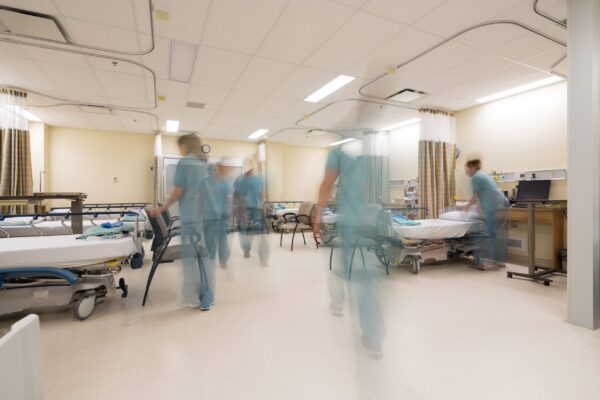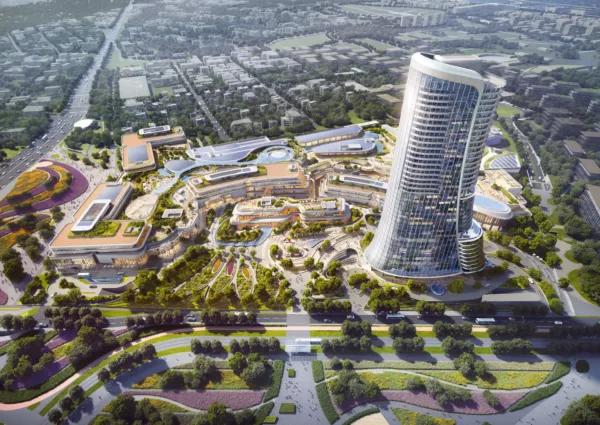
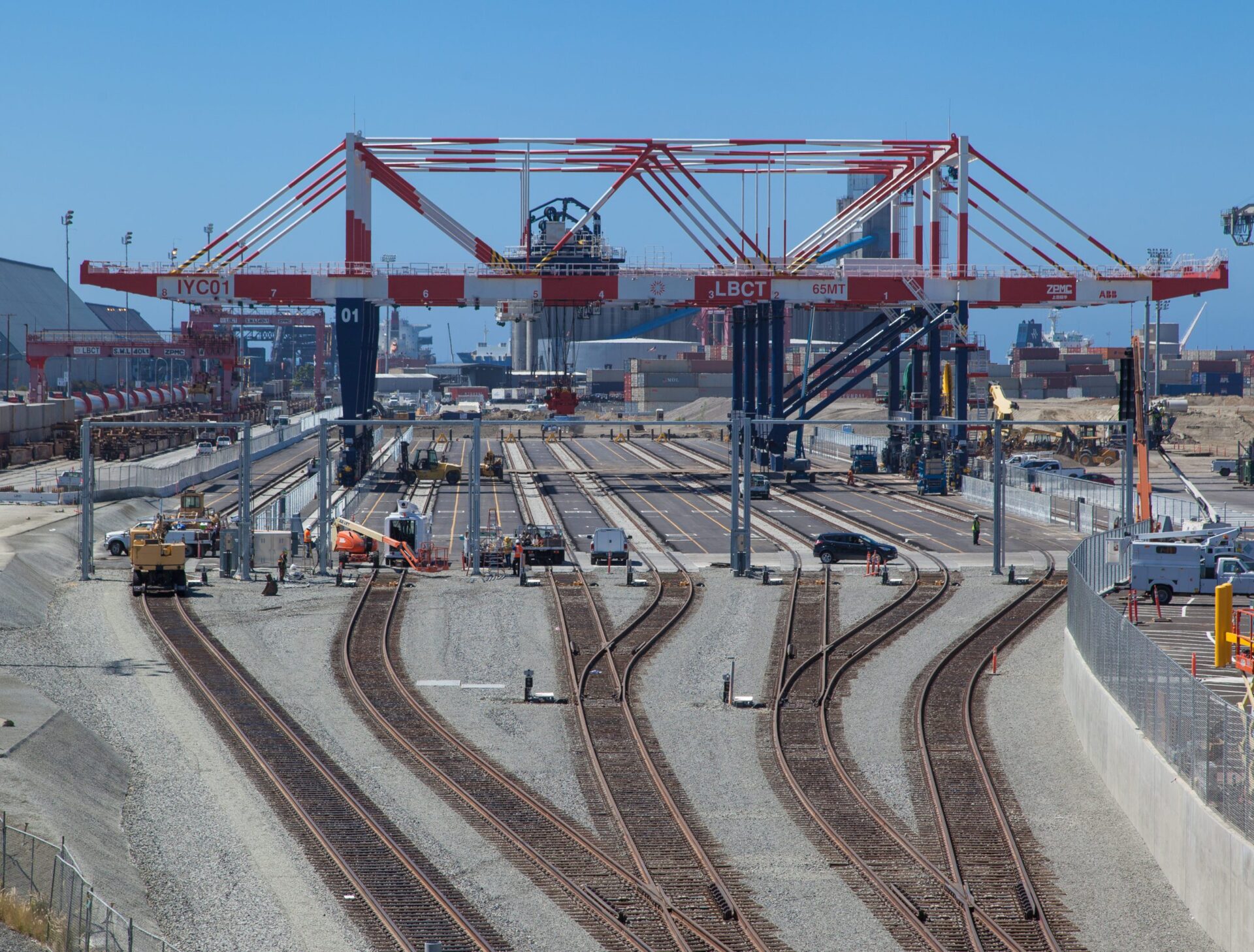
The Port of Long Beach (POLB) in Long Beach, CA, is undertaking a program to expand its on-dock rail capacity at Pier B, an existing rail yard at the Port’s northern boundary. The $870 million Pier B On-dock Rail Support Facility Program aims to ensure the Port meets increasing demand for rapid, global shipping. Hill International, Inc. is providing program management services to POLB for the Program.
Key components of the Program include the realignment of Pier B Street and Pico Avenue, closure of the 9th Street grade crossing, expansion of the existing yard from 9 to 38 storage tracks, addition of 6 lead tracks, expansion of inbound-outbound staging tracks to accommodate 5 trains up to 10,000 feet each, removal of the Shoemaker Bridge ramps and other streets between 9th Street and 12th Street, relocation of existing utilities, right of way/real estate purchases and lease adjustments, relocation of existing mainline tracks into the North Harbor area, and widening of the Dominguez Channel Bridge to accommodate an additional track.
Hill’s program management approach is helping to keep the Program’s many individual projects moving in sync and efficiently towards a successful conclusion.
The Big Picture
“The Pier B Program is extremely important for the Port’s long-term goals,” says Hill’s Consultant Program Manager for the Program, Vice President Matthew McMenamin, PE, QSP, QSD. One of the most important goals for the Port is environmental, says McMenamin.
Each departing train will save approximately 750 truck trips between the Port and off-dock rail yards, reducing roadway traffic congestion and Port-related air pollution. The Port also intends to work with regional rail lines to incorporate highly efficient electric-powered locomotives into its operations. In support of the Port’s green ambitions, the Hill team is leading program-wide sustainability workshops and identifying ways to achieve LEED certification.
In addition to helping the Port meet its environmental goals, the Program will help the Port make the most of its newly constructed, $1.5 billion Middle Harbor Program. Middle Harbor, a decade-long endeavor, involved transformative changes to the Port’s infrastructure—deeper channels, reconfigured terminals, expanded rail networks, taller cranes, extensive automation, and other facilities improvements to accommodate the future of global shipping.
“Pier B is a necessary corollary to Middle Harbor and other terminals in the Port,” says McMenamin. “It’s essential for the efficient shipment of all the extra freight coming into and out of the Port. Pier B will ensure Long Beach can continue to serve as a preferred gateway for trade between the Pacific Rim and inland destinations across the country, both now and well into the future.”
Enabling Early Access
With expected completion in 2024, the Pier B Program will have seen POLB under continuous construction for nearly 15 years. To expedite some return on its capital investments, the Port is setting out to build “Early Rail” projects that provide for operable rail capacity while the rest of the Program is built-out.
Hill helped the Port arrange priority packages to allow early operability while also facilitating the remainder of the work. McMenamin and his colleague Vice President Mihaela Stroe, PE, LEED AP BD+C, CCM, drew on prior experience with the Port and best practices for Port construction to package the early-release work. In fact, Stroe recently helped POLB package and execute early-release projects in Phase 3 of the Port’s Middle Harbor Program. The three separate Early Rail projects arranged by Hill and the Port include:
Plans are underway for two more Pier B early-release projects, to be managed by Stroe. These will include the relocation/construction of a pump station and the demolition of the Shoemaker Ramps. These projects are expected to be initiated later in 2021.
The early-release projects are also important for mitigating schedule threats. For example, there has been a significant delay in receiving the Final Environmental Impact Report Record of Decision. Having originally anticipated receiving approval in September 2020, the project team expects final approval in September 2021. While this constitutes a direct delay to the critical path, strategies such as early-release projects will improve schedule performance and expedite the date at which the Port can begin seeing revenue from their investment.
The Right Approach
The Port and Hill’s efforts to package priority projects are one part of a strong program management approach. Under the umbrella of program management, Hill’s services include program management staff augmentation; project management for individual projects; project controls; scheduling and estimating; design and constructability reviews; document control; real estate and right of way services; permitting; liaising with contractors, subcontractors, construction managers, and others working in the field; and coordination with a wide variety of stakeholders, such as the Coast Guard, the Army Corps of Engineers, adjacent companies, transit agencies and rail operators, utilities, and the City of Los Angeles.
To execute some of these services, Hill has engaged specialty sub-consultants, most of whom are small local businesses. This allows Hill to help the Port in a unified and consistent way, but constitutes a programmatic endeavor of its own.
“We have engaged many specialized subconsultants,” says McMenamin. “We have firms on the team focused on real estate, right of way, utilities, permitting, estimating, design review, and document control. Fortunately, we’ve prioritized a team approach from the outset, which has helped with coordination and getting deliverables done on time. A unified team approach helps us deliver our services and ultimately benefits the Port in a way a single-source program management team couldn’t on a program of this scale.”
Hill’s program management approach also incorporates lessons learned as a matter of course. For example, during the design reviews, the Hill team draws on experience from previous projects with the Port, such as the Middle Harbor Phase 3 project and Pier F & Ocean Boulevard Constructability Review. The Port has selected BlueBeam as the tool to review the plans and specifications, which is a collaborative web tool allowing multiple parties to review and comment at the same time, then consolidating comments for the designer’s use. The team is also undergoing a Program-wide risk review with Port consultant KKCS. This is capturing many known and unknown risks and lessons learned, to be applied to project budgets and schedules.
While the unified team of sub-consultants and approach to lessons learned have already benefited the Program, the most important benefit Hill brings as a program manager is the integration of its management team into the client’s organizational structure. For the Pier B Program, this also means matching the team’s values to the Port’s and making the Port’s mission Hill’s mission.
“POLB has several long-term goals,” says McMenamin. “These include keeping the Port competitive, developing and maintaining state-of-the-art infrastructure, improving the environment, and broadening community access to the Port. But they’re not just the Port’s goals, they’re our goals. That’s why a client brings Hill on, to have a third-party representative who not only knows how to handle the technical side of capital construction but is also entirely on their side.” By aligning the team’s mission with the Port’s, Hill helps ensure all Program decisions support of the Port’s overarching strategic goals.
Success on Both Horizons
This summer, Stroe and the Hill team helped bring the Port’s Middle Harbor program to a successful conclusion at Pier E. Now, with success behind them, Hill is helping the Port lay foundations for a successful Pier B Program.
“I think there is much that forecasts success,” McMenamin says. “We’ve already helped deliver projects for the Port and so we understand their expectations and management style. Hill’s program management process helps us capture and implement lessons learned, and we have a great team of sub-consultants all working for the Port’s benefit. We’ve also internalized the big picture of what the Port wants to accomplish. Even with the schedule challenges we’re facing, the whole team has the right attitude and the right skillsets to drive timely and cost-effective Program delivery.”
Positive indicators already support McMenamin’s forecast. The team has hit several key milestones, such as the completion of 30% plans for the Early Rail projects, the decision to advance the design for Early Rail to 50%, and state approval for the Environmental Impact Report.
“We have momentum,” McMenamin goes on. “And it’s a good thing too. This Program is a testament to how viable and green rail is—trains are an exceptionally efficient way to facilitate growth and help cut down on traffic. The new rail capacity is going to make a big difference for the Port and for the region, and we’re happy to be a part of the solution.”
Share
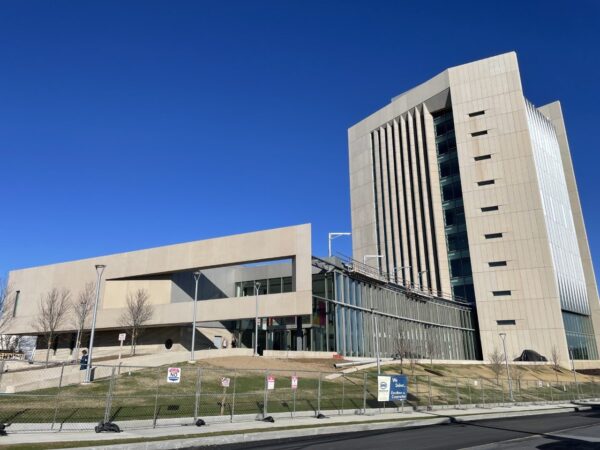
April 11, 2024 | Articles
A Model Move: Managing Move-In at the Sylvia H. Rambo U.S. Courthouse

April 8, 2024 | Articles

April 4, 2024 | Articles
Driving Growth and Seizing Opportunity: Lukasz Marcinkiewicz Joins Hill as Country Manager, Poland

April 1, 2024 | Articles

March 27, 2024 | Articles
Building the Future: Women’s Leadership and Community Engagement in the Construction Industry

March 25, 2024 | Articles
Leveraging Data Analytics and Dashboards for Enhanced Project Performance
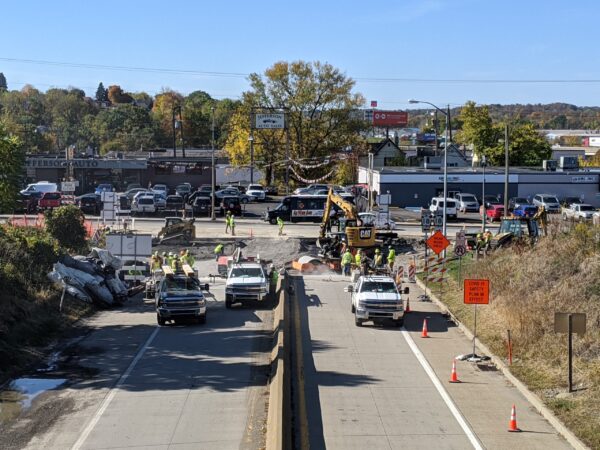
February 26, 2024 | Articles
Continuity, Creativity, and Collaboration: Delivering PennDOT’s Route 18 Signal Upgrade
We and use cookies and other tracking technologies to improve your experience on our website. We may store and/or access information on a device and process personal data, such as your IP address and browsing data, for personalised advertising and content, advertising and content measurement, audience research and services development. Additionally, we may utilize precise geolocation data and identification through device scanning.
Please note that your consent will be valid across all our subdomains. You can change or withdraw your consent at any time by clicking the “Consent Preferences” button at the bottom of your screen. We respect your choices and are committed to providing you with a transparent and secure browsing experience.
| Cookie | Duration | Description |
|---|---|---|
| cookielawinfo-checbox-analytics | 11 months | This cookie is set by GDPR Cookie Consent plugin. The cookie is used to store the user consent for the cookies in the category "Analytics". |
| cookielawinfo-checbox-functional | 11 months | The cookie is set by GDPR cookie consent to record the user consent for the cookies in the category "Functional". |
| cookielawinfo-checbox-others | 11 months | This cookie is set by GDPR Cookie Consent plugin. The cookie is used to store the user consent for the cookies in the category "Other. |
| cookielawinfo-checkbox-necessary | 11 months | This cookie is set by GDPR Cookie Consent plugin. The cookies is used to store the user consent for the cookies in the category "Necessary". |
| cookielawinfo-checkbox-performance | 11 months | This cookie is set by GDPR Cookie Consent plugin. The cookie is used to store the user consent for the cookies in the category "Performance". |
| viewed_cookie_policy | 11 months | The cookie is set by the GDPR Cookie Consent plugin and is used to store whether or not user has consented to the use of cookies. It does not store any personal data. |

